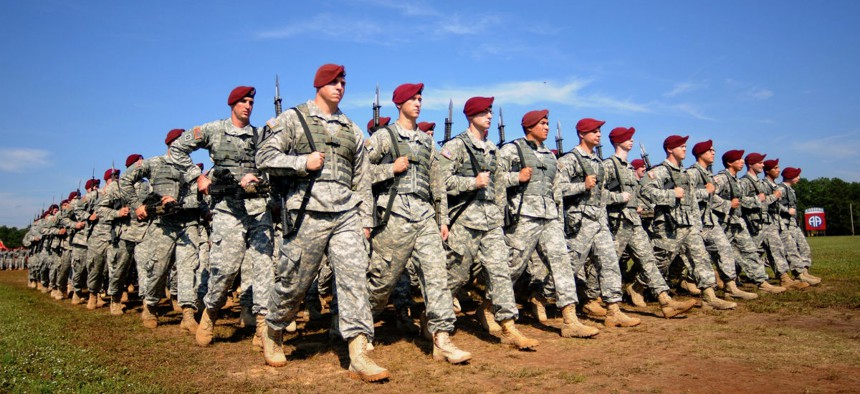New Army Camo, LGBT Guidance, Troop Pay Raise and More
A weekly roundup of federal pay and benefits news.
The House Appropriations Committee on Tuesday approved a $578.6 billion 2016 defense appropriations bill, which would give troops a 2.3 percent pay raise instead of the 1.3 percent requested by President Obama.
The pay hike would apply to all 1.3 million active duty personnel as well as 819,200 Guard and reserve troops. The bill also provides funding to maintain 100 percent of troop housing costs through the Basic Allowance for Housing, according to a summary of the legislation.
The bill, which is $24.4 billion above the 2015 enacted level and $800 million above the president’s request, now heads to the full House for consideration.
As the funding bill advances through Congress, the Army is making sartorial advances on the battlefield. Stars and Stripes reports that beginning July 1, the Army will roll out a new camouflage uniform featuring nine design changes (less Velcro) and a new accessories line (think belts and boots) in “a deeper tan and coyote brown.” According to the newspaper:
The “Operational Camouflage Pattern,” or OCP, that rolls out in a few weeks is in many ways similar to the MultiCam pattern worn for the last half decade or so in Afghanistan. Mostly, the OCP looks like a slightly less subtle and greener variant of that tried-and-true design. During the transition period — from July 1, 2015, to Sept. 30, 2019, — soldiers will be able to continue wearing the old sand-colored belts, T-shirts and combat boots with the new uniform.
The cost of the new uniform will be similar to the cost of the old one: $91.70 for a hat, blouse and trousers.
About 20,000 Indian Health Service employees will soon begin receiving, on average, an extra $33,000 after the agency settled a lawsuit filed by three labor unions over alleged violations of the Fair Labor Standards Act regarding overtime pay, Federal News Radio reported.
According to FNR, “Snider & Associates, the law firm representing the three unions and their employees, said a mediator helped the Indian Health Service and the unions come to an $80 million settlement.”
In a May 22 letter to tribal leaders, Indian Health Service Acting Director Robert McSwain said the claims stem mainly from HIS employees who covered shifts that would not otherwise have been covered.
"The majority of the settlement will be used to compensate these IHS employees . . . This settlement allows us to avoid future litigation costs and the possibility of future awards totaling hundreds of millions of dollars . . . A combination of current-year funds that have been obligated but not spent, and prior year funds that would have been available to pay salary obligations at the time that the work was performed, will be used to resolve the claims. The total settlement costs will be borne by the Service Units based upon salary obligations where the claims arose . . . A portion of the settlement will be paid from current, fiscal year 2015 funds. IHS intends to reallocate $20 million from the new staffing funding increase in the fiscal year 2015 appropriation, originally identified for the Kayenta Health Center in Kayenta, Arizona.
Agencies and employees looking for guidance on the rights of lesbian, gay, bisexual and transgender employees have a new resource. The Office of Personnel Management, the Equal Employment Opportunity Commission, the Office of Special Counsel and the Merit Systems Protection Board jointly released an updated guide: “Addressing Sexual Orientation and Gender Identity Discrimination in Federal Civilian Employment A Guide to Employment Rights, Protections, and Responsibilities.”
The nine-page tutorial explains the legal framework as well as the rights and responsibilities of agencies and employees alike. It also offers links to additional resources.



